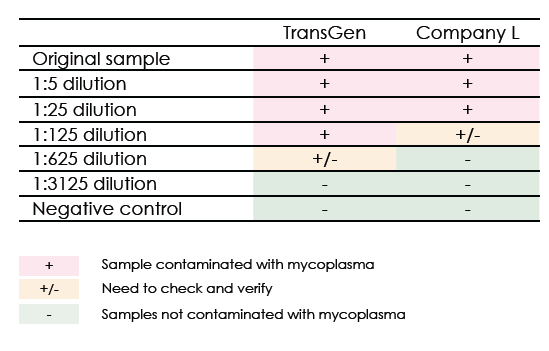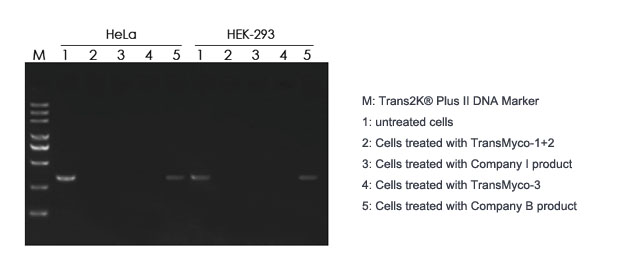The Damage of Mycoplasma Contamination
Mycoplasma contamination is probably the most prevalent and serious microbial contamination of cell culture systems used in research and industry today. It is estimated that about 5 to 30% of the world's cell lines are contaminated with mycoplasmas. It was reported that a higher contamination rate of 65 - 80% had ever occurred.
Mycoplasma leads to multiple negative impacts, such as inhibition of proliferation, increment in cell death, fragmentation of DNA and morphological features of apoptosis. Different troubles to laboratories may be induced, including loss of time, money, valuable cells and misleading publications, besides personal embarrassment and biosafety concerns. Furthermore, mycoplasmas are resistant to commonly used antibiotics and they cannot be detected visually by turbidity of fluid or under the inverted microscope. To learn more about Mycoplasma Contamination
TransGen Solutions for Mycoplasma Contamination
To overcome the troubles brought by mycoplasma contamination, TransGen Biotech provides comprehensive solutions for mycoplasma contamination including detection, prevention and elimination. We offer free samples for mycoplasma-solution products(To learn about the rules for getting free samples).

The Detection of Mycoplasma Contamination 
A large number of simple, reliable, sensitive and specific tests are now available to detect mycoplasma contamination in cell culture, including microbiological culture, DNA staining, molecular biology tests (e.g. PCR-based), biochemical assays (e.g. luciferase-based), immunoassays, electronic microscopy, FISH test, etc. We provide PCR-based and luciferase-based detection products, which are very popular for routine cell line maintenance. PCR-based detection methods are highly sensitive while luciferase-based method can provide more dependable and rapid results. To learn more about Mycoplasma Detection
Luciferase-based technology—— a more dependable and rapid method
TransDetect® Luciferase Mycoplasma Detection Kit (Cat. No. FM301)
• Fast workflow of 20-30 min.
• More specific and accurate: Only detect biologically active mycoplasmas.
• High sensitivity and easy to use.

Fig. 1 The detection of a dilution series of mycoplasma contaminated cell cultures using TransDetect® Luciferase Mycoplasma Detection Kit (Cat. No. FM301) and a reagent from Company L, which demonstrates higher sensitivity of detection using FM301.
PCR based method-high sensitivity & Nature cited
TransDetect®PCR Mycoplasma Detection Kit (Cat. No. FM311)
• High sensitivity: Able to detect as low as 20 copies of mycoplasma genome.
• High specificity: Only detect mycoplasma DNA, not eukaryotic and bacterial DNA.
• Easy to use: No need to extract genomic DNA, suitable for the detection of large–volume cell samples.
• Positive and negative control included: Ensure reliability and accuracy of the results.

Fig. 2 The detection of mycoplasma of different concentrations using TransDetect® PCR Mycoplasma Detection Kit (Cat. No. FM311-01).
Mycoplasma subtypes that can be detected accurately by FM311 and FM301
This includes, but is not limited to, the following subtypes:
M. Alkalescens, M. canadense, M. arginini, M. hominis,M. bovoculi, M. arthritidis, M. neophronis, M. salivarium, M.ovipneumoniae, M. zalophi, M. orale, M. hyorhinis, M. pneumoniae, M. hyosynoviae
 | It was cited in a Nature-published article (Xu, Daichao, et al., 2020) that the cells were tested every two months using TransDetect® PCR Mycoplasma Detection Kit (Cat. No. FM311) to ensure that they were mycoplasma-free. |
The Elimination of Mycoplasma Contamination 
Four general types of procedures have been used to eliminate mycoplasmas from infected cell cultures: physical, chemical, immunological and chemotherapeutic treatment (e.g. antibiotics). Administration of antibiotics is by far the most common and efficient approach. The products provided by TransGen are antibiotic-based.
TransSafe™ Mycoplasma Elimination Reagent (TransMyco-1+2) (Cat. No. FM401)
TransSafe™ Mycoplasma Elimination Reagent (TransMyco-3) (Cat. No. FM411)
• Remove mycoplasma effectively.
• Effective at low working concentrations with low cytotoxicity.
• Suitable for a wide range of cell types.
• Ready-to-use product that can be added directly to the culture medium.

Fig .3 Electrophoresis results of untreated cells and cells treated with TransSafe™ Mycoplasma Elimination Reagent (TransMyco-1+2) (Cat. No. FM401), the product from company I, TransSafe™ Mycoplasma Elimination Reagent (TransMyco-3) (Cat. No. FM411), and the product from company B.
The Prevention of Mycoplasma Contamination 
There are a variety of methods to prevent mycoplasma contamination: (1) Improve aseptic techniques and practices; (2) Avoid using mycoplasma contaminated cultures; (3) Only use antibiotics responsibly; (4) Discard or treat mycoplasma contaminated cells. (5) Quarantine new cells of any origin. (6) Reduce aerosol generation. TransGen has launched an antibiotic based method with low cytotoxicity for convenient mycoplasma prevention.
TransSafe™ Mycoplasma Prevention Reagent (Cat. No. FM501)
• Maximum preventive of mycoplasma contamination.
• Effective at low working concentrations with low cytotoxicity.
• Suitable for a wide range of cell types.
• Ready to use: Add to the culture medium directly.
• An alternative to Pen/Strep to prevent from common gram-positive and gram-negative bacteria.

Fig .3 Electrophoresis results of Mycoplasma-contaminated cells and cells treated with TransSafe™ Mycoplasma Prevention Reagent (Cat. No. FM501).
References
· Drexler H G, Uphoff C C. Mycoplasma contamination of cell cultures: Incidence, sources, effects, detection, elimination, prevention[J]. Cytotechnology, 2002, 39(2): 75-90.
· Nikfarjam L, Farzaneh P. Prevention and detection of Mycoplasma contamination in cell culture[J]. Cell Journal (Yakhteh), 2012, 13(4): 203.
· Falagan-Lotsch P, Lopes T S, Ferreira N, et al. Performance of PCR-based and bioluminescent assays for mycoplasma detection[J]. Journal of microbiological methods, 2015, 118: 31-36.
· Xu D, Zhao H, Jin M, et al. Modulating TRADD to restore cellular homeostasis and inhibit apoptosis[J]. Nature, 2020: 1-6.
Free Sample Rules for Mycoplasma-solution Products
As long as you leave a message including the code MYCO-SAMPLE on the website, a free sample can be provided for you to test the mycoplasma-solution products. Because shipping fee will be charged, we recommend you to get the free samples from local distributors.
Note: TransGen Biotech reserves the right to amend privileges, terms and conditions without prior notice.














